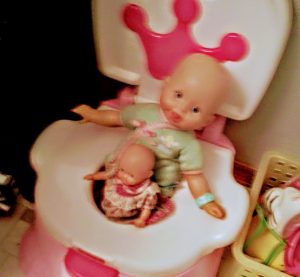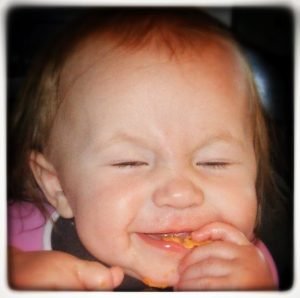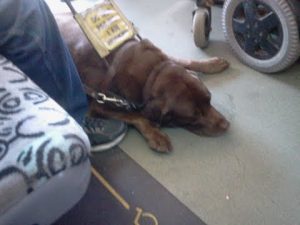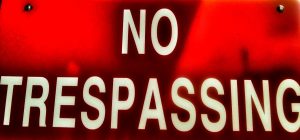3 Things Puppies and Toddlers Have in Common: Service-dog-in-training diary
This post will compare the toddlers in my life and own new puppy, a future service dog.
As I write I am reminding myself that puppies and toddlers have more than 3 things in common that we need to be aware of with our new service-dog-in-training.
1) All babies leak. 2) Don’t understand English 3) Eat and try to explore everything with the mouth
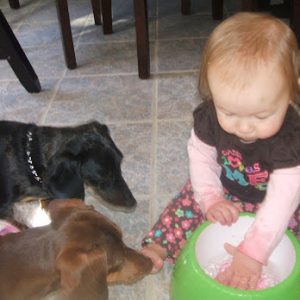
Toddlers and puppies have a lot of things in common. -see post for 4 things about puppies and babies. Sophi-Do-It is the toddler in the above image.No at age 6 Sophie-do-it can fill the same dog dish with water.
2 more bonus points to remember about toddlers and puppies;
4.Need for a loving grown up’s time and energy to keep them safe while learning how to “make good choices.” .
5.Sleep
…………………………………………………..
…The Short Version of the Story….
My No Non-cents Nanna followers have watched my youngest grand daughter grow from infancy to starting kindergarten. Now, you may follow along with our newest family member, Amber while we bond these first few weeks.
Amber was born in January. Now at 8 weeks old she has joined our family. We are all in training to be a service dog.
- Just when we could stop baby-proofing our apartment for when Sophie-Do-It came to visit, my son and I are now blessed with a puppy named Amber.
- Now we have to puppy-proof our small apartment for Amber’s safety until Amber learns to know better.
Please welcome, Amber, our new puppy. She is not just any puppy to house break, let chew up shoes, pee on the carpet nor slap a service vest on to avoid paying a pet deposit. She is an loving investment in time to train for 2 years to eventually assist my son, who has MS..
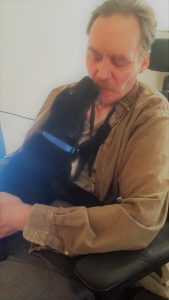
David Ellinger bonds with his puppy, Amber for the first time. Over the next 2 years Amber will be a service dog in training for David. Follow along as we a learn how to train Amber for her ‘job’.
- Amber was hand picked by Dana Ortiz Becoming the Trainer to be a service dog in training for the next 2 years before she is a full service dog for my adult son.. I will explain the ‘service dog in training’ in a later blog post.
- For now, we have a very special canine baby in our home who will go through similar issues my children and grand children have that I have written about in my old blog posts about behvaior management and safety.
-
We will train Amber, over the next 2 years to be a full service dog.
Just like any species of baby, this puppy has stages of growth and developmental milestones to go through. This puppy has to be trained from normal puppyhood before her service dog training begins. We want to start every habit off on the right paw so we won’t have to undo any bad habit not becoming of a service animal later on.
As I’ve been reading tips from Dana Ortiz of Becoming the Trainer, whom will be training us to train Amber, and watching the videos she has recommended I am reminded that I myself had extensive training and work with Behavoir Management of children during my career as Registered Nurse.
WOW! I can apply my expertiese with children as I get my thumbs or toes nibbleled at and wipe up puppy puddles of pee.
- Potty training: all babies leak waste. Their spinall cord nerves are not developed well enough to be able to control their muscles, yet.
- Cue words in English: All babies need time and repeition to learn to understand the sounds they hear in the language spoken. For our we are focussing on: puppy-potty, drink, hungry, off, sit, down, room (kennel), OUCH! Amber…
- EVERYTHING GOES INTO THE MOUTH! When any baby is born it has a natural instict to ‘root’ for mommys milk. The primary need is to suck to EAT and EAT some more. Vision is not the most important need. They can’t comprehend any visual object, yet. They must explore their immedicate world with their mouth in order to survive.
- Boundaries: For our puppy, Amber, we have to block off under the hospital bed. She crawled under to chew on electric wire to the remote control on the bed once. We had to stop that behavior. Then twice she crawled under to poop in private instead of the puddle pad. We had just gone outdside, but ‘went’ again under the bed. (I was not happy!)
- Even now, we will be re-directing away from shoes and toes towards what we do want Amber to chew on like a bone or a rope. Eventually, my son David will want Amber to pick up his shoes or a dropped cell phone. Amber will learn waht a shoe or a shrt is..but not allowed to chew on them while she is in the puppy chewing stage.
Note: this is a puppy observation diary, not a puppy training blog.
The End of the Short Story
No Non-cents Nanna writes MORE Nanna Details, of course:
Let’s explore the idea that all Toddlers and Puppies do have at least 3 basic things in common.
1. Babies and Puppies LEAK!..a lot!
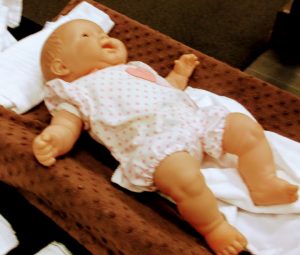
All infants needs time to develpe the muscle skill to control bowls adn bladder befroe attempting to potty train.
- All Toddlers and Puppies have to be potty trained when their spinal cord and muscles is developed suffciently enough..not before.
- Yes, Amber misses the puddle pad by 2 or 3 inches. ( She is still a baby. We have had her for almost 5 days as I type this.)
- Yes, Amber LEAKS! She does not make it all the way out side before she leaks.
- Yes! I am disappointed and some what minor horror at ahving to clean up poop when Amber misses the mark. But that is life. We keep going towards the goal without fan fare.
- In the time it took me to write this post Amber has pooped outside 3 times and once on the puddle pad; pee’d outside 6 times and still managed to make a puddle in the hall and once in the kitchen. And on her 3rd cat nap. That means I have stopped my writing this blog many times to attend to priorities for training this puppy.
- When Amber potties outside she gets reinforced by a big cheer / happy potty dance from Big Nanna
2. English Spoken Here: learning to communicate in the same language.
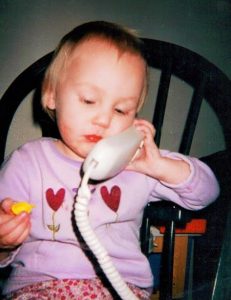
Communication in the same language is the key to getting children or puppies to behae in the way we wnat them to. Third oldest grand child at age 2.
Just like our human babies, puppies don’t understand a word we say until we learn the same language. Both infants and puppies will learn what ever language when we speak consisitent words from shear repitition within the context of behavior.
- I watch for cues to use the specifc words the puppy needs to know. An example would be to say POTTY when we see her squat and pee.. When she does her business outside I do the happy potty dance. ( No, I don’t care what the neighbors think. I’m training the dog!)
- When I put the lease on to walk the dog and she hears the sounds of the door ,eventually she will associate that I am taking her POTTY. I avoid getting excited about using the word POTTY (sh-h-hh-) until we get to the grassy area where I want her “go”.
- We have a HUGE challenge. The hallway in our building to get outside is oer 130 of my steps. Therefore, we use a few puddle pads inside. I really watch Amber’s cues, but I’v old. I move pretty slow. When I see her start to squat, I teach her the cue POTTY. I get up to re-direct her to her PUDDLE PAD. “POTTY. Potty on the PUDDLE PAD.”
- When Amber is able to control her muscles well she will have already learned the cue for POTTY.
FLASHBACK!
- It is my job to teach Amber to understand cues in English. Because she is chosen to be a service-dog, eventually. We want to not mess up early on having to undo bad habits.. My focus, for now is training Amber consitently. She is my priority.
I had relevant flashback to when I taught 3 to 5 year old foreign students to understand English at a Korean Baptist day care.The first 2 days on the job I kept trying to get twelve 3 and 4 year old non-English speaking students to be quiet by saying SH-h-h-h!
Everytime I said Sh-h-h-h 8 littlle boys weere wetting their pants as they made a mad sash off to the bathroom.
My BIG MISTAKE!
These 3 year old’s understood NOT a word in English. These children had litterally gotten off the airplanes from Korea, China, Japan and India.. They had not heard English spoken before.
On the 3rd day, the manager of the day care, a Korean woman, told me that when oriental mothers are potty training the boys they will say S-h-h-h-h to cue the boys to aim and pee in the toilet.
Uh-oh! My bad communication!
It was I who made them pee on demand. I was mis-communicating something i had not intended..
As smart as our new family member, Amber is, she is a dog who does not speak English. I have to teach her the words or postive sounds I want her to respond to. She does not understand my Engolish, yet.
- My point is to be selective about the cue words and responsive sounds we use when house breaking puppies and kids. They have to learn to speak our English.
- Now, I want switch directly to the more grown up point. Avoid responding to a puppy mistakes with inappropriate POTTY-MOUTH -you know what I mean. Getting upset will not help the puppy to do what we want it to when when nor where we want to have it done. Chill out then aim for success next time…beside potty mouth words may have a future that is not so helpful…
Think about this:
In the near future Amber will be taken on the city bus as service-dog-in-training. ( My son and I use public transportaion.) Now and then a fellow bus riders use POTTY MOUTH LANGUAGE with emphasis!!!! We don’t want our service-dog-in-training to “go” on a wrong cue, now, do we?
3. Toddlers and Puppies Explore with Their Mouths
- We must change our habits, now to avoid allowing a service-dog-in-training to accidentally eat something they picked up off the sidewalk or the floor would be harmful.
- We start by carefuly watching and training at a very early age of the pup. Just like we would protect our baby or toddler from tasting the wrong things or chewing on electrical cords.
- When Amber starts her training to ride the city bus she can NOT lick up food off the floor nor accept “treats” from stranger EVER!
Stop leaving purses and bags on the floor that might have dangerous objects to chew on: batteries; medicine; scissors; crayons, markers. ( I took this image when Sophi-Do-It was a baby a number of years ago for an old safety awareness post on No Non-cents Nanna.) Later on a full service dog will have learned not to touch without being told.
When toddlers begin to climb or puppy dog legs grown enough to get things off of the kitchen counters or tables we must re-think our patterns of putting things away. From experience I know that big puppies will snarf up a bowl of fruit or a bottle of Tums from the far back of the kitchen counter when left alone…Our pup in training is NOT left unattended like most pets are. We use a kennel when we need personal space and can not watch her.
Later on, when our pup is mature she will have been taught what she is supposed to be doing, “Working” attentively to my sons’ needs does not include geting into trouble.
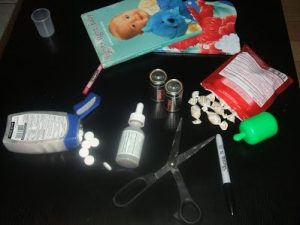
Baby-proof or puppy proof theses kinds of things. If you carry things like this in your gym bag or purse don’t leave your bag on the floor where baby or puppy can get into it.
I’m a craft-maker who has to make changes:
I drop tiny objects like straight pins and scraps of felt on the floor. That is not about to cahnge, so I moved my crafts out of the living room.
When our Sophi-Do-It was a toddler she loved my pin cushion. It was the “Holy Graile” of treasures to her for a while. ( You may reconize this image from an article I wrote in ELT a few years back.)
Now, Sophie-Do-It is learning to sew. I gave her a pink pin cushion of her own.
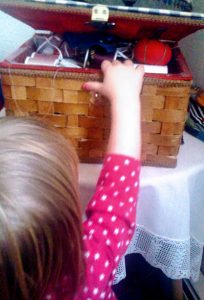
When my grand daughter Sophi-Do-It was a toddler she had a passion to get into my sewing box to see my pin cushion. Nw she has her own pin cussion as she learsn to sew. Our new puppy will love that pin cussion, too. Now I keep my crafting supplies closed in my room.
- Now with the puppy, Amber, I chose to move all of my craft-making into the bedroom, so, I can close the puppy out from any dangers.
I’m sure Amber the puppy would sink her tiny teeth into into my pin cussion, or lick up a straight pin off the floor.. I won’t take a chance, EVER.
Now it is your, really. What are your thoughts on toddlers and puppies?
Follow Amber Service Dog in Training on Facebook.
Views: 505


